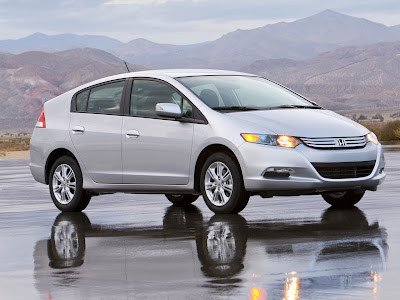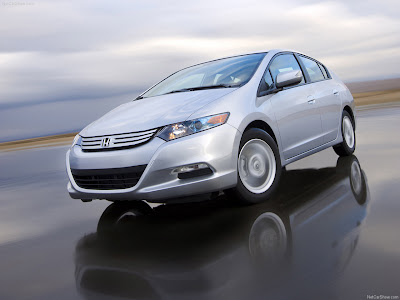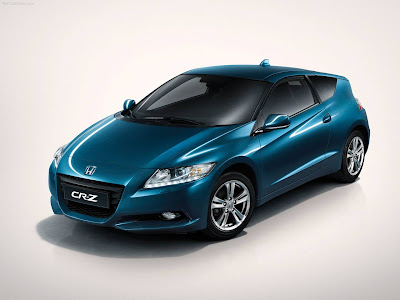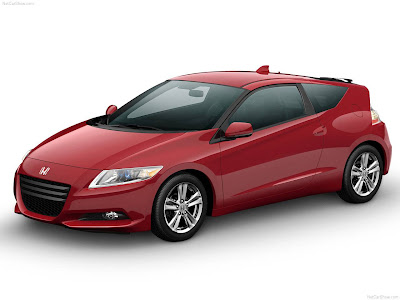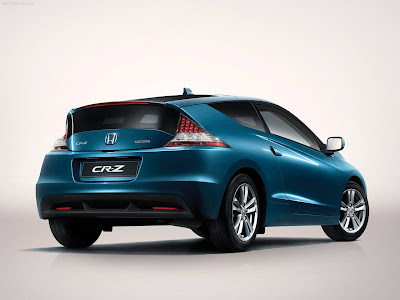2011 Honda CR-Z – Click above for high-res image gallery
Let's get this out of the way right now: the 2011 Honda CR-Z is not a CRX redux. To compare the two – no matter how much
Honda may want to – is to misunderstand the former and besmirch the latter.
No, the hybrid CR-Z is an entirely different beast. Despite its three-door shape and two-seat configuration, it has about as much in common with the O.G. hatch as a big-screen remake of your favorite childhood TV show. The basic components are there, but the whole concept has been throttled to within an inch of its life with high-tech gadgetry, odd casting decisions and a questionable demographic.
But to Honda's credit, its rhetorical comparisons to the CRX have died down considerably since the CR-Z debuted in concept form and then progressed into a production model. Honda may have recognized after a lukewarm introduction outside the U.S. that glomming onto nostalgia will only get you so far (see: Dodge Challenger and Chevrolet Camaro). And to make something special – a vehicle that transcends the emotional baggage of its predecessor – you've got to evolve the concept and avoid relying on rose-tinted sentimentality.
To an extent, that's exactly what Honda has created. It hasn't built another hot hatch – the lightweight, K20-powered three-door enthusiasts crave – and instead it has attempted to meld the technology of the moment into a greenified competitor to the Mini Cooper. Think of it as the rogue lovechild of the original and current Insight, with a few sporting genes spliced into its DNA. But can a hybrid hatch be an entertaining steer? We took to California's twisties and clipped a few cones to find out.
If you were completely smitten by the CR-Z concept from the 2007 Tokyo Motor Show, the retail model may leave you a bit cold. Viewed side-by-side, the basic elements are there – high hatch, wedge shape, massive snout – but as with so many designs rotating on pedestals, everything's been watered down in the production process.
The deeply recessed grille and its center mounted "H" have been dispatched for a more pedestrian-friendly nose, while the blistered fenders, glass roof and aggressive haunches have all been relegated to the designer's trash bin. We won't call it neutered, nor will we result to the roller-skate cliche, but the CR-Z's 16-inch wheels (the only hoops available) and higher ride height have laid to waste the concept's edgy aggressiveness. And the first time a state-mandated front license plate is fitted, crouching Bugs Bunny references won't be far behind.



On the positive side, the blacked-out A- and B-pillars combined with the highly contoured windshield and greenhouse provide a pleasant wrap-around effect, while the high, split-glass hatch and triangular taillamps lend the CR-Z a more purposeful stance. The visibility afforded by the thinner A-pillars – something that's largely absent on modern vehicles – is a breath of fresh air, but on the flip side, the tall hatch and massive C-pillars make lane-changes a double- then triple-check affair.
Viewed as a whole (and if you hadn't seen the concept), it's a smart, youthful design with dozens of subtle stylistic elements that catch your eye over time. The only thing that's obviously missing is a visible exhaust outlet – something akin to the integrated exhaust tips on the Euro-market Civic would've been a nice touch.




The interior does a better job of tipping you off to the CR-Z's sporting pretenses, beginning with a pair of sufficiently bolstered seats and a small diameter steering wheel. All the controls are canted towards the driver, including the optional sat-nav, standard climate controls and drive mode selectors. The dash doesn't extend as far forward as we would have expected given the steeply raked windshield, nor does it completely encompass the occupants (note the odd cliff-face on the passenger side of the dash).
Mercifully, Honda has decided to ditch the Civic's two-tiered instrument panel for a center-mounted pseudo-3D tach with a technicolor digital speedo mounted in the middle. Battery and charge status, shift indicator, fuel level and real-time consumption flank the sides and look both futuristic and slightly half-baked. If you must, think of it as a low-rent version of the Ferrari 458 Italia's driver command center, complete with a user-customizable Multi-Information Display for standard trip readings, along with an Integrated Motor Assist (IMA) flow indicator, "Eco Guide and Eco Scoring" and exterior temperature reading.




Fit and finish is on par with anything from Honda in the $20,000-25,000 segment, with soft-touch materials lining the major touch points and an interesting vacuum-formed metal coating the door handles (an industry first). The rear cargo area was obviously designed with kid seats in mind for the European and Japanese market, but in the U.S. we get a pair of recessed, carpeted plastic trays in their stead. The upright panel can be folded down to expand the standard 25.1 cubic feet of cargo space, although the only way to fold or snap it into place is to move the front seat forward and reach through the door opening. Thankfully, it's a single-handed affair.
With all the techno-tidbits available inside (along with standard USB audio and a 12V power source), oddly, our favorite interior feature came in the form of a configurable cargo cover. You can mount the vinyl overlay in three different ways to either completely obscure the cargo area or leave it open for luggage, golf bags or small bodies. But the third setup – humorously dubbed "Secret Mode" – creates a small parcel area at the very end of the hatch to hold smaller items (grocery bags, laptop and camera cases) so they won't shuffle around during spirited sprints. Speaking of which...

If you're not already aware, the CR-Z's roots are based on the new-for-2010 Insight hatch. You can groan now if you wish, but take solace in the fact that Honda has managed to shorten the wheelbase to 95.8 inches, widen the track to 59.6 inches in front and 59.1 inches in the rear, with a total length of 160.6 inches. MacPherson struts work in concert with 18-mm front and rear stabilizer bars, and the whole setup has been fitted to a suitably taut chassis. The bad news: We're stuck with a torsion-beam suspension in the rear. The worse news: the curb weight comes in between 2,637 and 2,707 pounds depending on the transmission and equipment levels. For reference, the four-passenger, five-door Insight tips the scales at 2,734 pounds, which isn't much difference at all.
As you'd expect, Honda's focus lies on the CR-Z's Integrated Motor Assist hybrid system and its 1.5-liter i-VTEC four-cylinder pulled from the Fit. In the five-door runabout, the four-pot is good for 117 horsepower and 106 pound-feet of torque, but combined with the IMA system's Ni-Mh battery and brushless DC motor, Honda rates the CR-Z with the six-speed manual at 122 hp at 6,000 RPM and 128 lb-ft of torque from a deceivingly shallow 1,000 to 1,750 RPM. Honda says the electric motor is good for 13 hp and 58 lb-ft of twist on its own, so we're not entirely sure how the maths work out on that. We've left it to our engineering-savvy Mr. Abuelsamid to parse out the details, so let's get to the driving.


Judged by the stats alone, we started up the CR-Z with more than mild trepidation. In the Fit, the 1.5-liter isn't exactly an inspired engine and sadly, that hasn't changed in this application. The engine note is more hotel-grade Oreck than the manic, high-revving Hondas of yore, and as you move up through the rev-range, the wasps under the hood get angrier but fail to deliver a sting.
With the traction control switched off, the IMA delivers just enough torque to spin the tires when you launch around 3,000 RPM. Acceleration through the first two gears is on the high-side of acceptable as the four-pot strains towards its 6,500 RPM redline, but by the time you reach third, most of the steam has escaped the engine bay. Our best guesstimate on a 0-60 mph time is somewhere in the 10-second range. Hardly stirring, but not unexpected.
However, off-the-line performance isn't the CR-Z's forte. If Honda's "Hybrid Cafe Racer" line is to be believed, this hatch's true calling is in the canyons. And here, a faint light shines through.


In Normal and Eco mode, the CR-Z trundles along as you'd expect; a lazy commuter focused on efficiency. However, press the Sport button and the steering and throttle tighten. Inputs are more direct as you crank the quick ratio steering (2.5 turns lock-to-lock) and the shifter effortlessly slips through the gears. The six-speed manual tranny is slightly notchier than other Honda 'boxes, but it inspires you to row up and down the ratios to find the meat of the powerband. Lay into the throttle in third or fourth and there's more noise than motivation, but when the first corner appears, the brakes haul down the CR-Z at a decent clip. On the road, brake fade remained absent, but during a few hot laps around a makeshift autocross course, pedal feel got progressively mushier as we pushed harder and braked later, particularly when attempting to stop in a cordoned-off cone box.
Steering is typical Honda: direct, if slightly overboosted. Initial turn-in and mild mid-corner corrections were encouraging, as is the additional weight of the rear-mounted battery pack, allowing the CR-Z to rotate quicker than other short-wheelbase three-doors we've sampled. That additional pounds and 60:40 weight split inspired confidence through high-speed sweepers, but the downside is a fair amount of body roll through trickier, twistier bits and a penchant for understeer without a good flick of the wheel or a fair amount of trail-braking.

We only had a brief stint in a CVT-equipped model, and the seamlessness of the start-stop system in the manual version was replaced with a more abrupt shudder when switching back on from a stop – exactly as we've experienced on the Insight. As with most CVTs, the "elastic band" sensation is there, albeit slightly more refined, holding the revs at around 6,000 rpm when matting the throttle and allowing you to shift through seven faux ratios when the mood strikes you. As you'd expect, the manual is easily the more sporting setup, but Honda estimates somewhere between 70 and 75 percent of all CR-Z's will be equipped with the quasi-automatic. Which brings up the obvious question: Who's the CR-Z for?
If we were a cynical bunch, we'd assume it's yet another vehicle designed to improve overall CAFE ratings. And with fuel economy ratings of 36/39 mpg city/highway with the CVT and 31/37 on the manual model, it's certainly going to help. But that's too easy. If you believe Honda, it's estimating that the average buyer will be a style and eco-conscious consumer between 25 and 35, smitten by the small size and blue Hybrid badge on the boot. That we can almost buy, particularly given that Honda will be pricing the base model under $20,000 and the fully-kitted EX with Navi will slide in under $24,000 when it goes on sale August 24. But is it an enthusiast's vehicle? Hardly. With more power, bigger brakes and a more sophisticated suspension (we're sure Hasport is working on a engine mount kit as you read this), this could've been the CRX for the 21st century. Instead, it's a capable fuel miser that can muster some sport when summoned. Unsurprising, but disappointing nonetheless.
cource by autoblogger




































